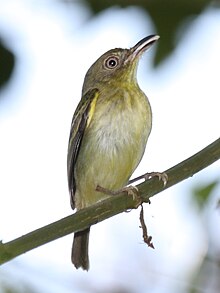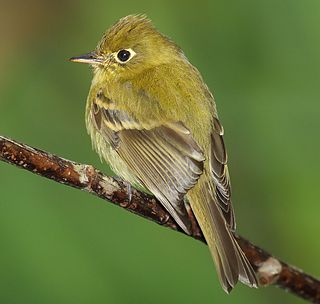
The tyrant flycatchers (Tyrannidae) are a family of passerine birds which occur throughout North and South America. They are considered the largest family of birds known, with more than 400 species. They are the most diverse avian family in every country in the Americas, except for the United States and Canada. The members vary greatly in shape, patterns, size and colors. Some tyrant flycatchers may superficially resemble the Old World flycatchers, which they are named after but are not closely related to. They are members of suborder Tyranni (suboscines), which do not have the sophisticated vocal capabilities of most other songbirds.

The Tyranni (suboscines) are a suborder of passerine birds that includes more than 1,000 species, the large majority of which are South American. It is named after the type genus Tyrannus. These have a different anatomy of the syrinx musculature than the oscines, hence the common name of suboscines.

The genus Empidonax is a group of small insect-eating passerine birds in the tyrant flycatcher family, the Tyrannidae. The genus name Empidonax is from Ancient Greek empis, "gnat", and anax, "master".

Pyrocephalus is a genus of bird in the tyrant flycatcher family, Tyrannidae.

Myiarchus is a genus of birds in the tyrant flycatcher family Tyrannidae. Most species are fairly similar in appearance and are easier to separate by voice than by plumage.

The ash-throated flycatcher is a passerine bird in the tyrant flycatcher family.

Rhynchocyclus is a genus of tyrant flycatchers. Established by Jean Cabanis in 1836.

The shrike-tyrants are a genus, Agriornis, of birds in the tyrant flycatcher family Tyrannidae. The members of this genus are found in open habitats in western and southern South America, usually at high elevations. They are large and heavy billed by tyrant-flycatcher standards, and include the largest representative of the family, the great shrike-tyrant. These five species all have a dull brownish or greyish plumage. Despite their name any similarity with the shrikes is superficial. Many field guides note their greater resemblance to thrushes.

The pale-eyed pygmy tyrant is a species of bird in the tyrant flycatcher family, Tyrannidae, where it makes up the monotypic genus Atalotriccus.

Twistwings are two species of Tyrant flycatchers from the genus Cnipodectes. They are restricted to northern and western South America and southern Central America. The genus was monotypic until a new species, Cnipodectes superrufus, was described from Peru and Bolivia in 2007. Their common name refers to the modified primaries. The genus contains two species.

Knipolegus is a genus of birds, the black tyrants, in the tyrant flycatcher family Tyrannidae.
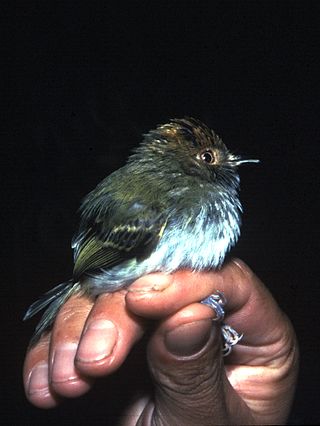
Lophotriccus is a genus of South American birds in the tyrant flycatcher family Tyrannidae.

Mecocerculus is a genus of birds in the large tyrant flycatcher family Tyrannidae.

Mionectes is a genus of birds in the tyrant flycatcher family Tyrannidae.

Myiopagis is a genus of bird in the family Tyrannidae, the tyrant flycatchers. These species are closely related to the genus Elaenia but are generally smaller.

The southern mouse-colored tyrannulet is a species of bird in the tyrant flycatcher family Tyrannidae. It occurs in a wide range of scrubby and wooded habitats in tropical and subtropical South America, being absent from the southernmost part of the continent, the high Andes and dense rainforest. It is generally common, but its small size and dull plumage results in it often being overlooked – or at least not identified, as it resembles several other tyrant flycatchers.

Nesotriccus is a genus of Central and South American birds in the tyrant flycatcher family Tyrannidae.

Serpophaga is a genus of birds in the tyrant flycatcher family Tyrannidae that are found in Central and South America.
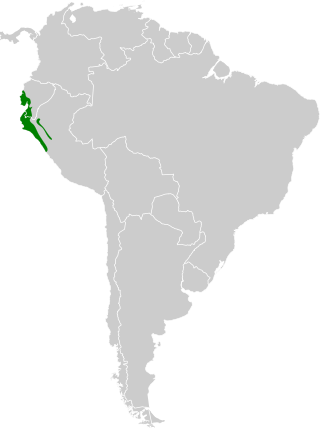
The Tumbesian tyrannulet or Tumbes tyrannulet is a species of bird in the tyrant flycatcher family Tyrannidae. It occurs in desert scrub and wooded habitats in southwest Ecuador and northwest Peru. Within its restricted range it is fairly common, but its small size and dull plumage results in it often being overlooked – or at least not identified, as it resembles several other tyrant flycatchers. The common name is from the city of Tumbes in northwest Peru.
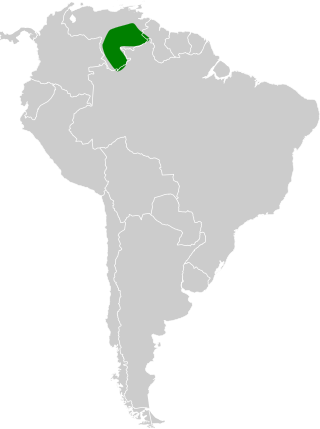
The Sierra de Lema flycatcher or Tepui flycatcher is a species of bird in the tyrant flycatcher family Tyrannidae. It is found in highland areas, including the table-top mountains (tepui), of southern Venezuela and the neighbouring parts of Brazil and Guiana. Its natural habitats are moist montane forests.
